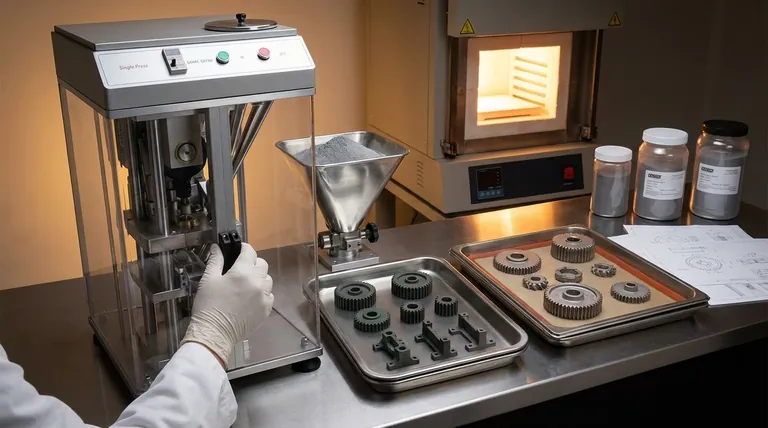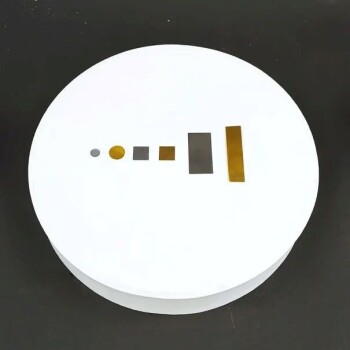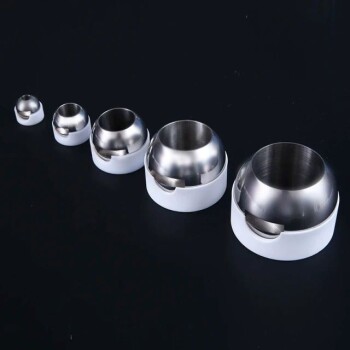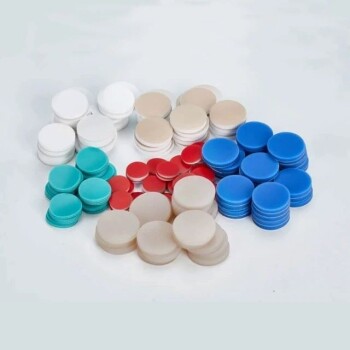At its core, a sintered part is a solid object created by taking a fine powder—typically metal or ceramic—and subjecting it to intense heat and pressure. This process fuses the powder particles together into a solid mass without melting the material, allowing for the creation of intricate components that are often difficult or costly to produce through traditional machining.
Sintering is fundamentally a manufacturing technique that transforms powdered material into a dense, solid part. Its primary advantage lies in its ability to economically produce complex, near-net-shape components at scale, bypassing the material waste and extensive labor of subtractive methods like CNC milling.

The Sintering Process: From Powder to Part
The creation of a sintered part is a precise, multi-stage process. Each step is critical for ensuring the final component meets its required density, strength, and dimensional accuracy.
Step 1: Compaction (The "Green State")
The journey begins with a carefully selected powder. This raw material is poured into a die cavity shaped like the final part.
Under immense pressure, the powder is compacted into a fragile, self-supporting shape. This preliminary object is known as a "green" compact or part in its "green state." It has the desired geometry but lacks the structural integrity for any practical use.
Step 2: Sintering (The Fusing Stage)
The delicate green compacts are carefully arranged on ceramic trays designed to minimize movement and distortion.
These trays are then loaded into a high-temperature, atmosphere-controlled furnace. The temperature is raised to a point below the material's melting point but high enough to trigger atomic diffusion between the powder particles. This bonds the particles together, densifying the part and giving it significant strength.
Why Choose Sintering? Key Advantages
Sintering is not a universal solution, but it offers powerful benefits for specific manufacturing challenges, making it a cornerstone of modern production.
Manufacturing Complex Geometries
The process excels at producing parts with intricate or complex shapes. Features like internal voids, undercuts, and varying wall thicknesses can be molded directly into the green compact, eliminating the need for difficult machining operations.
Achieving Near-Net-Shape
Sintered parts are typically near-net-shape, meaning they emerge from the furnace very close to their final, required dimensions. This drastically reduces or eliminates the need for secondary finishing processes like grinding or milling, saving both time and material.
High-Volume Cost-Effectiveness
While initial tooling costs can be significant, the high speed and automation of the sintering process make it exceptionally cost-effective for mass production. Minimal material waste and reduced labor contribute to a lower per-part cost.
Specialized Material Properties
Sintering allows for the creation of unique material blends and structures. For example, reaction sintering uses a chemical reaction during heating to achieve high densification with very little shrinkage, making it ideal for large and complex ceramic structures like high-temperature kiln furniture or optical mirrors.
Understanding the Trade-offs
To use sintering effectively, it's crucial to understand its limitations and the considerations that guide its application.
Inherent Porosity
Unless secondary densification processes are used, most sintered parts retain a small amount of residual porosity. This can impact mechanical properties like tensile strength and fatigue resistance when compared to a part machined from a solid, fully dense billet.
Managing Shrinkage
Parts shrink as they densify in the furnace. This shrinkage is predictable but must be precisely calculated and controlled during the design of the tooling to ensure the final part meets dimensional tolerances.
High Initial Tooling Costs
The hardened steel dies required for compaction are expensive to design and manufacture. This high upfront investment means sintering is generally not economical for prototypes or very low-volume production runs.
Making the Right Choice for Your Application
Selecting sintering depends entirely on your project's goals for complexity, volume, and material properties.
- If your primary focus is high-volume production of complex metal parts: Sintering is an excellent choice for components like automotive gears, sprockets, and engine components where net-shape manufacturing provides a significant cost advantage.
- If your primary focus is creating large, temperature-resistant ceramic structures: Reaction-sintering processes are ideal for manufacturing components for kilns, nozzles, and heat exchangers with minimal shrinkage and high final density.
- If your primary focus is unique material characteristics: Sintering can be used to create intentionally porous parts for filters or self-lubricating bearings by impregnating the porous structure with oil.
Ultimately, sintering provides a powerful method for efficiently creating complex parts when its unique process characteristics are aligned with the final product's requirements.
Summary Table:
| Key Aspect | Description |
|---|---|
| Process | Compaction of powder into a 'green' state, followed by heating below melting point to fuse particles. |
| Primary Advantages | Produces complex geometries, near-net-shape parts, cost-effective for high volumes, and enables unique material properties. |
| Common Materials | Metals (e.g., for automotive gears) and ceramics (e.g., for kiln furniture). |
| Ideal For | High-volume production of intricate components where traditional machining is inefficient or wasteful. |
Need reliable lab equipment for sintering processes or material testing? KINTEK specializes in high-performance furnaces, compaction tools, and consumables for laboratories working with powdered metals and ceramics. Whether you're developing new sintered components or scaling up production, our expertise ensures precise temperature control and consistent results. Contact us today to discuss how KINTEK can support your sintering R&D or manufacturing needs!
Visual Guide

Related Products
- Single Punch Electric Tablet Press Machine Laboratory Powder Tablet Punching TDP Tablet Press
- High Purity Gold Platinum Copper Iron Metal Sheets
- Custom PTFE Teflon Parts Manufacturer for PTFE Mesh F4 Sieve
- Custom PTFE Teflon Parts Manufacturer for PTFE Ball Valve Seat
- Custom PTFE Teflon Parts Manufacturer for Gaskets and More
People Also Ask
- What is a punch tablet press? Precision Tableting for R&D and Small Batches
- What are the different parts of a single punch tablet machine? The Core Components Explained
- What are advantages of single punch tablet press machine? Maximize R&D Efficiency with Minimal Material
- What is tablet pressing in pharmaceutical industry? The Core Process for Producing Solid Oral Dosage Forms
- What are the different pill presses? Choose the Right Machine for Your Lab or Production Scale



















